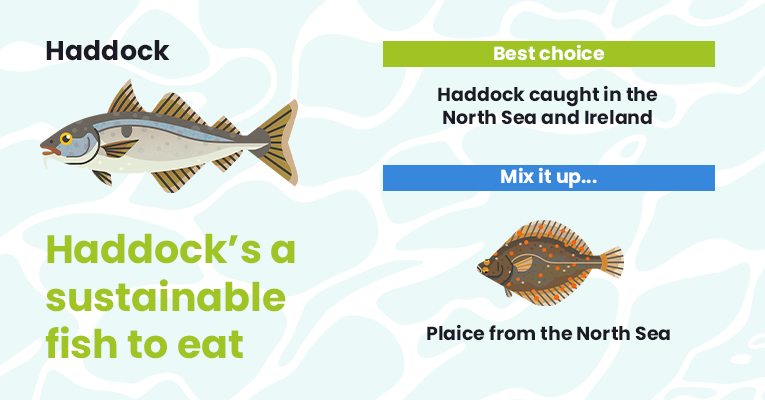
Top 5 sustainable seafood swaps
Did you know that 80% of the seafood we eat in the UK is made up of just five different species? We call them the big five: cod, haddock, salmon, tuna and prawns.
Not only is that really boring, but it's a pretty bad idea. It puts a lot of pressure on a handful of wild stocks and creates demand that drives unsustainable fishing and farming practices.
Take a look at what swaps you could make below and visit our Good Fish Guide to see how sustainable the seafood on your plate is.
Cod
Cod is one of the UK's favourite fish, often found in fish and chips dinners. It's a cold-water fish that is generally wild-caught rather than farmed. UK stocks are a mixed picture as a result of overfishing. Atlantic cod is available all year round but it's most abundant in autumn and winter.
A sustainable swap: hake
Thanks to good management and beneficial environmental conditions hake is now a great sustainable choice.
European hake has a very similar texture to cod: meaty and flaky. Swapping is as simple as substituting same weight/quantity in almost all recipes.

Tuna
Tuna are a top predator that can grow up to 3m long and weigh as much as a horse! Most of the tuna we eat is wild-caught from the ocean. There are lots of different species and some are more sustainable than others.
Make sure you check the Good Fish Guide if you're going to eat tuna as some species and fishing methods are red rated 'Fish to Avoid'! The species and fishing method are usually listed on tins and packets - try the ingredients list.
Best choice
- Skipjack or albacore tuna caught by pole & line or troll
What to avoid
- Pacific and Southern bluefin tuna
- Yellowfin tuna from the Indian Ocean
- Tuna caught by gillnet or drift net
A sustainable swap: sardines
Sardines from the southwest UK are a great choice thanks to healthy population sizes and a low impact fishing method.
Sardines are classed as an oily fish meaning it’s packed full of omega-3’s and nutrients.
If you don’t fancy whole sardine fresh from the fish counter, then try tinned, they're just as good!

Prawns
Sourced from all over the world, prawns can be sustainable, depending on what species they are, and where and how they were caught or farmed – check the Good Fish Guide.
Generally, prawns with an eco-label like Organic, MSC or ASC are the best choice.
Best choice
- Wild cold-water prawns from the Northeast Arctic
- Farmed prawns labelled Organic or ASC-certified
- Creel-caught Scottish langoustines (also known as Dublin Bay prawns or scampi)
What to avoid
- Uncertified king and tiger prawns farmed in Indonesia, Vietnam and India
A sustainable swap: mussels
Give warm-water king and tiger prawns a rest - choose UK rope-grown mussels instead. They’re one of the most ocean-friendly choices you can make.
They are grown using low-impact methods, harvested by hand, and get all the food they need from the sea around them. They cook in no time, and are packed full of protein and nutrients. What’s not to love?

Salmon
Popular for its tasty, pink flesh packed full of omega-3 fatty acids, salmon is a versatile fish that can be caught from oceans, lakes and rivers, or farmed. Both methods have some issues. Atlantic salmon is struggling in the wild and numbers are dangerously low. Intensive farming methods can lead to environmental problems. Farmed salmon feeds include wild-caught fish, which may not be sustainably sourced. Most of the salmon found in UK supermarkets will be farmed Atlantic salmon.
You can read more about salmon here.
Best choice
- Pacific salmon (pink, red or keta) caught in Alaska
- Organic or ASC-certified farmed salmon
What to avoid
- Wild-caught Atlantic salmon
A sustainable swap: farmed trout
Closely related to salmon, farmed trout is a great alternative. Look for rainbow trout farmed in freshwater ponds in the UK for the best options.
Trout has a very similar texture to salmon, with a slightly stronger flavour (it’s even more delicious in our opinion!). It’s really widely available in supermarkets and easy to swap fillet for fillet in a recipe.

Haddock
Also a chip shop favourite, haddock is generally a sustainable wild-caught option. However haddock often swim in the same areas as cod, meaning haddock fisheries may catch both species. You can protect juvenile fish by only buying fish that are larger than 30cm and avoiding buying fresh fish during the main breeding season of March and April.
Best choice
- Haddock from the North Sea
- Haddock from Scotland, Iceland or Norway
- MSC-certified haddock
What to avoid
- Small fish, less than 30cm
A sustainable swap: plaice
Why not try plaice from the North Sea, where stocks are booming? Plaice is a flat fish with a light, flaky texture and a mild flavour. It's delicious pan fried with a simple herb butter.

We should all try to diversify the seafood in our diets. By mixing up your meals, you’ll help remove some of the strain placed on a handful of farms and fisheries, you'll be supporting more UK suppliers and, who knows, you might discover a new favourite fish.
Health recommendations
The NHS recommends eating two portions of fish per week, but there are guidelines on the amount of certain fish that babies, children and pregnant or breastfeeding women should be consuming. See www.nhs.uk for more info.
The seafood advice on this page is correct as of October 2023.
Is the fish on your plate red-rated?
Search our Good Fish Guide ratings and find out now


